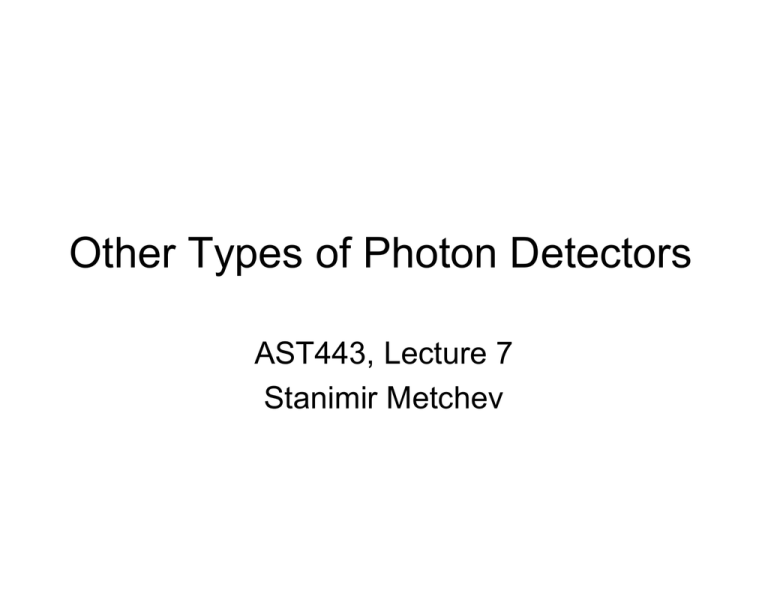Other Types of Photon Detectors AST443, Lecture 7 Stanimir Metchev
advertisement

Other Types of Photon Detectors AST443, Lecture 7 Stanimir Metchev Administrative • Project 1: – due today • Project 2: – observing proposals • • • • 1 page scientific justification 1 page technical justification, including target list 1 page for figures, tables, references print 4 copies and bring to class – due in class on Tuesday, Sep 29 (note Monday schedule!) • Reading: – chapters 4–5 of Howell: CCD data reduction and photometry – chapters 3–5 of Wall & Jenkins: statistics, correlations, hypothesis testing 2 Outline • Overview of previous lecture – CCDs • Other kinds of photon detectors – infrared – x-ray, gamma-ray – submillimeter, radio • Basic imaging data reduction 3 Basic Concept • • electron-hole pair generation doping: – n-type (electrons) – p-type (holes) – creates additional energy levels within band gap – increases conductivity • silicon (Si) – band gap: Eg = 1.12 eV • cut-off wavelength λc = 1.13µm hc 1.24 µm = E g E g (eV) – free-electron energy: 4 eV (3000Å) – 1 photon -> 1 electron "c = ! 4 Basic Concept • • electron-hole pair generation doping: – n-type (electrons) – p-type (holes) – creates additional energy levels within band gap – increases conductivity • silicon (Si) – band gap: Eg = 1.12 eV • cut-off wavelength λc = 1.13µm hc 1.24 µm = E g E g (eV) – free-electron energy: 4 eV (3000Å) – 1 photon -> 1 electron "c = ! 5 Basic Concept: A P-N Photo Diode • depleted region – low conductivity – can support an E field • • • net positive charge (higher charge density near top) additional E-field applied subsequently generated electrons get trapped in potential well near top 6 CCD Charge Transfer 7 Outline • Overview of previous lecture – CCDs • Other kinds of photon detectors – infrared – radio – gamma-ray – x-ray • Basic imaging data reduction 8 Near-Infrared • 1–5 µm • Si sensitivity drops off at >1.1 µm • InSb (“indium antimonide”) – – – – hc 1.24 µm "c = = E g E g (eV) Eg ~ 0.22 eV at 77 K λc = 5.6 µm need low temperature (~ 30 K) Keck IR cameras; Spitzer IRAC 3.6 and 4.5 µm ! • Hg(1–x)CdxTe (“mercury-cadmium-telluride, mer-cad-tel”) – Eg = 1.55 eV for x = 1; λc = 0.8 µm – Eg can be brought down to ~0 eV (metal) 9 NearInfrared • • HgCdTe detector signal carriers: holes – cf. electrons in CCDs • • • if l is small, hole can diffuse to depleted region before recombining hole is driven across depleted region producing current pixels can be read out photon absorption layer – individually(!), in principle – non-destructively (Rieke 2007) 10 Near-Infrared (x) • hc 1.24 µm "c = = E g E g (eV) Hg(1–x)CdxTe (“mercury-cadmium-telluride, mer-cad-tel”) – Eg = 1.55 eV for x = 1; λc = 0.8 µm – Eg can be brought down to ~0 eV (metal) ! – Hg0.55Cd0.45Te has λc ~ 2.5 µm • can operate at higher temperature (LN ~ 75 K) • Palomar IR cameras • HST WFC3 – can, in principle, work to very long λc 11 Mid- and Far-Infrared • 5–40 µm – Si:Ga (λc ~ 18 µm) – Si:As (λc ~ 28 µm) • Spitzer Space Telescope – IRAC 5.8 and 8.0 µm, IRS 5–15 µm, MIPS 24 µm • only form readily available in large format arrays – Si:Sb (λc ~ 40 µm) • Spitzer IRS (15–35 µm) • 40–100 µm (bolometer arrays) – Ge:Ga • Spitzer MIPS (70 µm and 160 µm) • cooled by super-fluid liquid He to 1.5 K • ~100 pixels – Ge:B, Ge:Sb, GaAs:Te 12 Readout of IR Arrays • can be done non-destructively – follow up the ramp sampling – Fowler-N sampling: read noise reduced as 1/√N (G. Finger et al.) 13 Readout of IR Arrays • can be done non-destructively – follow up the ramp sampling – Fowler-n sampling: read noise reduced as 1/√n • smaller (InSb) arrays with individual pixel readouts – after ADC conversion signal from each readout can be stored – multiple non-destructive readouts can be co-added before saving the image – theoretically, no limitation on object brightness (no saturation) but: – readouts are not instantaneous (~ few ms duration) – N co-adds increase read noise as √N (G. Finger et al.) 14 Extreme UV, X-Ray, γ-Ray • extreme UV – 10–100 nm [120–12 eV] – EUVE (Extreme UV Explorer, 1992–2001) • soft/hard x-ray – 1–10 nm / 0.01–1 nm [0.12–120 keV] – Einstein, RöSat, XMM-Newton, Chandra • (soft) γ-ray – 0.001–0.01 nm; <0.001 nm – 0.12–1.2 MeV; >1.2 MeV – EGRET, BATSE 15 X-/ γ-ray Photon Detection: Proportional Counters • high-E photon removes outer-shell electrons – x-rays: use Ar + organic gas – γ: use solid Ge • N (electron-ion pairs) ∝ Ephoton – has energy resolution! • amplification possible by setting high voltage cathode anode 16 X-ray Photon Detection: Scintillation Detectors • • • • x-ray photon removes electrons from deeper shells; is fully absorbed higher-energy electron fills “hole”, emitting visible photon (scintillation) strength of flash depends somewhat on Ephoton (some energy resolution) amplification possible through a PMT 17 X-Ray Photon Detection: CCDs! • need thicker substrates to ensure photon absorption • 1 photon → multiple photoelectrons: – energy resolution! (Kitchin 2002) 18 Submillimeter and Radio • (sub)millimeter (microwave) – 100 µm – 10 mm (3 THz – 30 GHz) – bolometer arrays (~300 mK operation temperatures) – telescopes: SMA (submillimeter array), JCMT, ALMA (Atacama Large Millimete Array) • radio – >1 cm (<30 GHz) – antennae – Arecibo, VLA (Very Large Array) 19 Submillimeter (Microwave) • bolometer arrays • thermistor = ultra-sensitive thermometer – converts temperature variations to electric signals (Ge:Ga) 20 Submillimeter (Microwave) • bolometer arrays • thermistor = ultra-sensitive thermometer – converts temperature variations to electric signals (LABOCA bolometer on IRAM 30 m telescope) 21 Radio Detection • detect electric signal from EM radiation directly – includes amplitude and phase information – at MHz frequencies, use a dipole antenna placed at telescope focus half-wave dipole antenna three half-wave dipole antenna 22 Radio Detection • detect electric signal from EM radiation directly – includes amplitude and phase information – at MHz frequencies, use a dipole antenna placed at telescope focus half-wave dipole antenna Arecibo 305 m telescope (30 MHz – 10 GHz) 23 The Multiwavelenth Milky Way 24 Outline • Overview of previous lecture – CCDs • Other kinds of photon detectors – infrared – x-ray, gamma-ray – submillimeter, radio • Basic imaging data reduction 25 Detector Calibration (Project 1) • bias frames – non-zero bias voltage – 0s integrations • dark frames – equal to science integrations • flat field frames – QE of detector pixels is non-uniform in 2-D – QE is dependent on observing wavelength • bad pixels 26 Reduced Image vs. Raw Images 27






